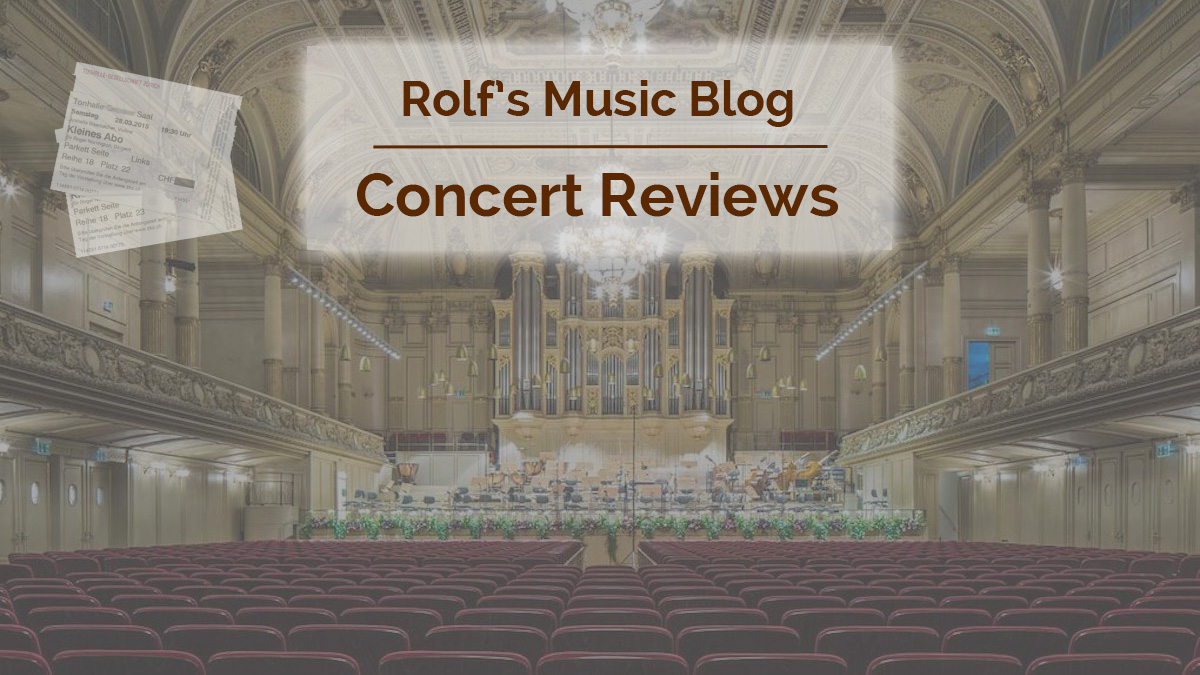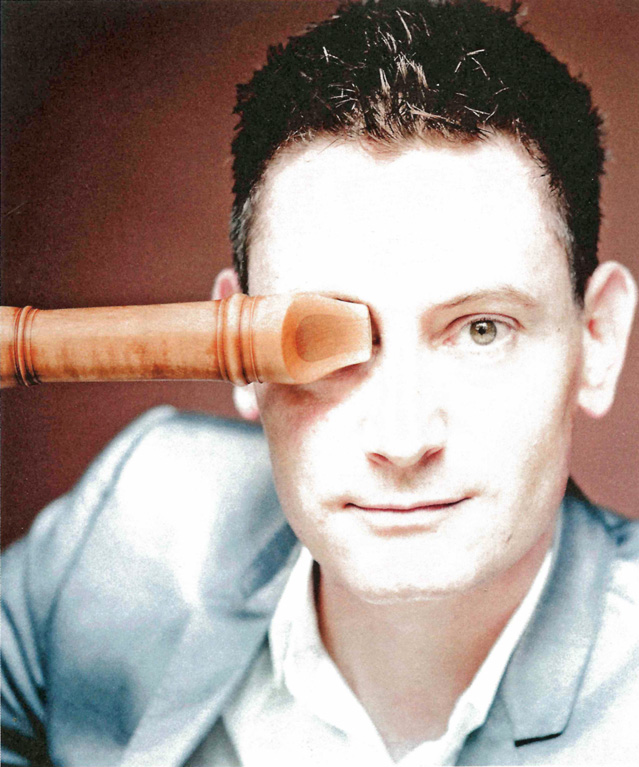Maurice Steger Playing Antonio Vivaldi
With the Zurich Chamber Orchestra
Tonhalle Zurich, 2014-10-28

2014-12-01 — Original posting
2016-07-29 — Brushed up for better readability
Table of Contents
- The Artists
- Playing Vivaldi
- Concerto in C major for strings and continuo, RV 114
- Recorder Concerto in D major, “La pastorella”, RV 95a
- Cello Concerto in E minor, RV 409
- Concerto in G minor, “La notte”, RV 439
- Concerto for Flautino, Strings and Continuo in D major, “Il gardellino”, RV 428
- Concerto in B♭ major, RV 375
- Concerto in G major for Flautino, Strings and Continuo, RV 443
- Encores — Concerto in D minor “per molti strumenti” RV 566
- Addendum 1
- Addendum 2: CD
The Artists
On Maurice Steger
Some media are proclaiming Maurice Steger the “world champion of the recorder”. I think this is a rather odd statement, as one cannot measure musical interpretation. Music remains subjective, both on the side of the artist, as well as in the listener’s perception and receptivity. However, it is certainly legitimate to state that Maurice Steger’s recorder playing is in the world’s very top league.
Needless to say that he could count on meeting an enthusiastic audience here in Zurich. After all, he was born in Winterthur, so he is local to the area. He has been a teacher at the local music conservatory, and he has made numerous appearances in the region both as soloist and as conductor. All this besides touring the world with his instruments, and making highly acclaimed recordings. Several of his CDs I also discussed in earlier postings in this blog.
The Zurich Chamber Orchestra
In this concert, Maurice Steger played with the Zurich Chamber Orchestra (Zürcher Kammerorchester, ZKO). That’s a chamber orchestra founded in 1945 by Edmond de Stoutz (1920 – 1997). The ensemble has made tremendous progress over the past two decades: it now presented itself as a veritable, competent baroque ensemble, playing with 5 + 4 violins, 3 violas, 2 cellos, one double bass, harpsichord, theorbo/baroque guitar, and a hurdy-gurdy. The strings players used baroque bows and played without vibrato, violins and violas standing.
Playing Vivaldi
The evening also served as presentation for Maurice Steger’s latest CD, featuring compositions by Antonio Vivaldi (1678 – 1741). Steger recorded that CD with I Barocchisti under Diego Fasolis (see the addendum below). This concert featured six out of seven concerti from this CD, plus additional works by the same composer.
Some might ask whether it is a good idea to fill an entire evening with so many works of one and the same baroque composer. Given the short attention span with the younger generations, and the amount of distraction that our “multimedia life” is offering today, it is more common to mix works by several composers, or to mix baroque works with newer, if not even modern compositions. Luckily, that evening proved that such concerns were pointless, thanks to Maurice Steger’s competent, lively, vivid, multi-faceted playing!
Concerto in C major for strings and continuo, RV 114
It was a clever move to begin the evening with the concerto in C (RV 114) for strings and continuo. The first movement (Allegro) starts rhythmically, but all in pp, forcing the audience to listen carefully. Instantly, people found themselves immersed in and captured by the world of baroque music. Without interruption, the slow movement, a short, but virtuosic cadenza (Naoki Kitaya at the harpsichord), formed a transition to the last movement, a Ciacona.
Recorder Concerto in D major, “La pastorella”, RV 95a
Even before that last movement ended, the stage door silently opened, giving way to the archaic sound of a hurdy-gurdy, whose player stayed on the stage for the following concerto. That was a witty transition, a pleasant surprise, as well as a fitting complement to the recorder concerto in D, “La pastorella”, RV 95a.
Cello Concerto in E minor, RV 409
The following cello concerto in E minor (RV 409) saw a performance in an unusual configuration. The soloist (Nicola Mosca, first cellist in the orchestra) was playing in the upper right, in the rear corner of the stage, together with a theorbo and a second cellist, resembling the concertino formation in a concerto grosso, while the tutti formation remained in the front of the stage.
From the point-of-view of coordination, this setup wasn’t a problem at all. However, acoustically, I felt that it was far from ideal, at least in this concert hall, despite its much-praised acoustics. Even though Nicola Mosca played with warm, full tone and used vibrato to stand out from the group, his part was somewhat marginalized. The theorbo was hard to hear at all from behind the two string instruments. One could feel the challenge in maintaining proper intonation between the two cellos (one with, the other without vibrato). It might have been better to keep the concertino in the front, and to place the tutti formation in a more distant position.
Concerto in G minor, “La notte”, RV 439
The following two pieces are well-known favorites: the concerto in G minor, “La notte” (RV 439) for alto recorder, strings and continuo, and the concerto for flautino, strings and continuo in D major, “Il gardellino” (RV 428). “La notte” starts with a Largo, which Steger played with deliberately over-stretched rests and contrasting, virtuosic solo inserts. The subsequent Presto movement “Fantasmi” (nightmares, ghosts) exhibited Steger’s virtuosity in a neck-breaking tempo. A dreamy, wonderfully calm Largo “Il sonno” (the sleep) formed a complementing part. Finally, an ultra-fast final Allegro, completed this concerto. Here, it was impossible for the audience to follow all the notes in the solo part, let alone the soloist’s fingers.
Concerto for Flautino, Strings and Continuo in D major, “Il gardellino”, RV 428
Without interruption, a short, slow cadenza (the awakening of the day) led into the twittering of the goldfinch in “Il gardellino”. Here, Maurice Steger evoked the presence of not just one finch, but flocks of birds. He did this with a virtuosity that led the audience to interrupt the concerto with (well-deserved) applause. Some might have started dreaming in the flourishing, melodic Largo with its rich ornamentation in the solo part. But the final Allegro, again in extreme tempo, interrupted those dreams. Here, one could sense that the placement of the two violin groups on opposite positions on the stage provided good acoustic balance, but also proved to be more demanding for the coordination within the orchestra, in comparison to an arrangement with the violins on the same side of the podium.
A note on the instrumentation in the continuo group: the slow, melodic movements featured a theorbo, which provided a sonorous foundation that complemented the harpsichord. For many of the fast, rhythmic movements, the player switched to the baroque guitar, supporting the percussive, rhythmic aspects.
Exaggeration?
An inexperienced listener might state that Maurice Steger is exaggerating the tempo, while at the same time overloading these concertos with his abundant ornamentation, making it hard or impossible to recognize the melody. It is true that often, one can merely sense outlines of the melody, given Steger’s wild trills, tremoli, inserted scales, provokingly long appoggiaturas, extreme staccato, up to percussive whistling and overblowing. But on the other hand, I would claim that Steger only really exploits these features to the limits (and maybe occasionally beyond), where pieces / movements are (too) well-known. He may just be trying to avoid the dangers of “earworm music”.
Sure, well-behaved, clinically clean playing are not his prime goals. His focus is the joy of playing, the fantasy, the pleasure of exploring the span of technical feasibility. As a listener, I think it is fascinating and a real pleasure to see how he and his fellow musicians enjoy playing this music!
Concerto in B♭ major, RV 375
The repertoire in recorder concerti is small. With around 20 concerti, Antonio Vivaldi was the most productive baroque composer in this genre. So, after the intermission, Steger proceeded with the concerto in B♭ major, RV 375, originally a violin concerto. It’s one of Vivaldi’s late compositions. Steger played it on a descant recorder in B. In the result, it was virtually impossible to recognize the original solo instrument assignment. On the other hand, in my view, this wasn’t one of Vivaldi’s top compositions: without Steger’s rich ornamentation, one might have felt some lengths, especially in comparison with the richness of the preceding compositions.
Concerto in G major for Flautino, Strings and Continuo, RV 443
The last item in the official program, the concerto in G major for flautino, strings and continuo (RV 443) is again well-known, the applause well deserved, both by the soloist as well as the orchestra.
Encores — Concerto in D minor “per molti strumenti” RV 566
The musicians honored the applause with the last movement from the concerto in D minor “per molti strumenti” RV 566 (originally for two recorders, two oboes, two violins, bassoon, strings and continuo), whereby for the part of the second recorder the young artist Céline Pasche from Lausanne (who is also playing that part on the CD) got a chance for a short appearance on stage. The real end of the program (announced as the “bouncer piece”) was the repetition of the last movement from RV 443. It was a truly entertaining evening!
Addendum 1
For the same concert, I have also written a (much shorter) review in German for Bachtrack.com. This posting is not a translation of that German review, the rights of which remain with Bachtrack. I create the German review using a subset of the notes taken during this concert. I wanted to enable my non-German speaking readers to read about my concert experience as well. Therefore, I have taken my original notes as a loose basis for this separate posting. I’m including additional material that is not present in the Bachtrack review.
Addendum 2: CD
Maurice Steger’s new Vivaldi CD deserves a separate review. Note that not only is there a different orchestra (I Barocchisti under Diego Fasolis), but also the instrumentation is different / richer, especially in the continuo (organ, archlute, salterio). There are additional wind instruments (oboes, bassoon). The concerto per molti strumenti (RV 566) appears in the proper, full setting. The concerto “Il gardellino” is present in the version for recorder, oboe, violin, bassoon and continuo (RV 90). Also the concerto “La pastorella” is played with that same setting, as published under RV 95. The CD also includes the concerto in G minor for recorder, oboe and bassoon, RV 103, not featured in the concert with the Zurich Chamber Orchestra. Here’s the CD information:
Vivaldi: Concerti per flauto RV 90, 95, 103, 375, 439, 443, 566
Maurice Steger, Céline Pasche
Diego Fasolis, I Barocchisti
harmonia mundi France, HMC 902190 (CD, stereo); ℗ / © 2014
Booklet: 28 pp. fr/en/de






